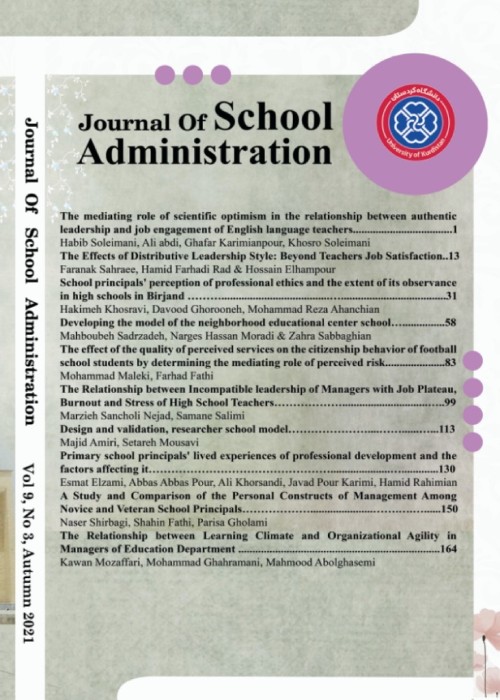Investigating the Psychometric Properties of principals' instrucional Management Rating Scale (PIMRS-22)
Increasing quantitative and qualitative development of the structure of the country's educational system, course content, the complexity of organizational issues of schools, professional development of teachers and the expectations of other institutions and organizations and parents and the educational system; It is necessary to pay attention to improving management and educational leadership. In order for schools to be effective, principals must have more professional competencies and competencies than others. School effectiveness requires setting and creating tools and scales to measure leadership effectiveness. Over the past few decades, researchers have used a number of conceptual frameworks to describe the various characteristics of educational leadership. The most well-known conceptual framework that has been used extensively is the PIMRS Scoring Learning Scale (PIMRS). As mentioned, Hallinger and Murphy (1985) present a model of educational leadership using three dimensions: "Defining the mission of the school" defines the role of the principal in working with others to ensure that the school Uses specific, measurable, and time-based goals for students' academic achievement. "Curriculum management" means the principal focuses on coordinating and controlling the school curriculum and education. The "development of a positive school learning atmosphere" is based on the idea that effective schools create academic emphasis through high standards and expectations for students and teachers. Evidence presented in various studies suggests that the Manager Educational Leadership Rating Scale (PIMRS) can play a potentially useful role in empirical research leadership research. The PIMRS tool appears to provide reliable information about educational leadership; When grades are obtained from teachers. The PIMRS framework and tools have been used in many studies (Hallinger et al., 2015). Although a large number of studies have been performed using PIMRS; But the evidence for its reliability and validity is relatively limited in different countries. The purpose of this study was to investigate the psychometric properties of the PIMRS-22. The research method was descriptive correlational. The statistical population of the study was 3064 teachers from 422 schools in Ardebil province. in the academic year 2018-19 with a total of 3064 teachers. A sample of 418 students was selected by using proportional stratified random sampling from 202 schools. The factor structure of this scale was studied in two stages using two methods of exploratory factor analysis and confirmatory factor analysis. Research data were analyzed using SPSS22 & AMOS22 software. In exploratory factor analysis, data were analyzed by principal component analysis with varimax rotation. Performance indicators were good. Three factors with eigenvalues greater than one were found. These three factors can explain 74.227% of the variance. Confirmatory factor analysis results showed that the three-factor structure of the questionnaire including: school mission definition, Managing Instructional Program and Creating School Learning Climate, had a good fit with the data (X2/DF=1.661; CFI= 0.930; RMSEA=0.076). Analysis of reliability and convergent and discriminant validity of the questionnaire constructs showed that the questions are sufficiently accurate in measuring the questionnaire constructs. Therefore the questionnaire is highly reliable. Overall, the results showed that the questionnaire had good psychometric properties, and all 22 items remained without removing or modifying the scale. In the present study, PIMRS-22 was first translated from English into Persian. Then, in order to confirm the accuracy of the translation process, the translated Persian version was translated into English again and compared with the original form. Finally, the translated version of PIMRS-22 was reviewed by two instructors and two teachers. After preliminary implementation, the necessary changes were made to the ambiguous discourses, which were distributed to school teachers as the final scale was prepared. Therefore, according to the findings of this study, it is inferred that the improvement of the education system in Iran requires the acceptance of a model that can provide appropriate paths and solutions for all variables proposed in this study and all their dimensions, and also during the period. Specify the executive guarantee. In this regard, the implementation of the model "concept of educational leadership" proposed in this study with its comprehensive features can be a good model for the management of education and training in Iran and help achieve their goals. It seems that managers 'leadership style is influenced by factors such as the basis of authority and the type of perception of managers' assumptions, the individual's behavioral reactions, and finally organizational factors. In the Iranian education system, people usually reach out to management and educational leadership through a teacher. For this reason, they probably do not have a proper understanding of management and educational leadership in mind. They look at the work of teaching management and leadership from the perspective of teachers. Although this attitude is good and necessary, it is not enough. The role of educational management and leadership should be played with regard to all elements and effective factors in the educational environment; Therefore, people who are assigned to school management should be equipped with special knowledge, attitudes and skills. School principals should pay serious attention to human relations management in school management and base their management style on participation and cooperation. It is important for schools for students to learn in a participatory and friendly way, and for staff to work collaboratively and share their knowledge and skills. Better learning happens when there is a strong and effective relationship between school and home.
- حق عضویت دریافتی صرف حمایت از نشریات عضو و نگهداری، تکمیل و توسعه مگیران میشود.
- پرداخت حق اشتراک و دانلود مقالات اجازه بازنشر آن در سایر رسانههای چاپی و دیجیتال را به کاربر نمیدهد.



